English - Ontario Association of Children's Aid Societies
English - Ontario Association of Children's Aid Societies
English - Ontario Association of Children's Aid Societies
Create successful ePaper yourself
Turn your PDF publications into a flip-book with our unique Google optimized e-Paper software.
These three cultural groups have been sub-divided in many ways based on federal<br />
legislation and under First Nations governance:<br />
> > 127 bands are recognized under the Indian Act<br />
PRACTICE TIP — DATA IMBALANCE<br />
Data has been collected in <strong>Ontario</strong><br />
about First Nations people since<br />
Confederation (1867). The information<br />
on Métis peoples and the Inuit have<br />
only now begun to be collected in<br />
<strong>Ontario</strong>. At times, there will be more<br />
information available for First Nations<br />
people but it is important not to<br />
extrapolate and assume it relates to all<br />
other Aboriginal groups.<br />
> > 133 communities are represented by the Chiefs<br />
<strong>of</strong> <strong>Ontario</strong><br />
> > First Nations communities in <strong>Ontario</strong> fall<br />
under specific Treaties or agreements with<br />
the federal government including: Union <strong>of</strong><br />
<strong>Ontario</strong> Indians, Grand Council Treaty #3,<br />
Nishnawbe Aski Nation (James Bay Treaty #9),<br />
<strong>Association</strong> <strong>of</strong> Iroquois and Allied Indians and<br />
the Independent First Nations<br />
In addition, First Nations are organized under<br />
a clan system. All communities have both<br />
overlapping and distinct cultural characteristics.<br />
According to Aboriginal Affairs and Northern Development Canada:<br />
> > Of the recognized Status Indians as described by the federal government,<br />
almost half live on 206 reserves or settlements belonging to <strong>Ontario</strong>’s 127 First<br />
Nations. These communities are located across the province, from near<br />
Windsor in the south to the shores <strong>of</strong> Hudson Bay in the north.<br />
> > One in four <strong>Ontario</strong> First Nations is a small, remote community, accessible<br />
only by air year round, or by ice road in the winter<br />
> > There are another 91,478 Status Indians living <strong>of</strong>f-reserve<br />
THE CLAN SYSTEMS<br />
HAUDENOSAUNEE CLAN SYSTEM<br />
The Iroquois Confederacy is composed <strong>of</strong> six nations. Each nation has clans. A person’s<br />
clan is the same as their mother’s clan. The members <strong>of</strong> each clan are all related to<br />
each other through their mothers. This is called a matrilineal system. Each clan is<br />
represented by a different animal. Traditionally a person would not marry someone<br />
within the same clan.<br />
There are presently nine clans — divided into animals from three earth elements: Land,<br />
Air and Water. The water creatures are the turtle, beaver, and the eel. The land creatures<br />
are the deer, wolf, and bear. The creatures <strong>of</strong> the sky are the hawk, heron, and snipe. The<br />
natural world is symbolized by these beings. Prior to the Peacemaker, there were<br />
numerous other clans such as sweet potato, rock, and ball. After the formation <strong>of</strong> the<br />
Iroquois Confederacy, the number <strong>of</strong> clans wars reduced to the nine represented above.<br />
48<br />
All <strong>of</strong> the Six Nations have members from the Bear, Wolf, and Turtle clan while some<br />
nations also have members from some or all <strong>of</strong> the remaining six clans. Clans are<br />
headed by clan mothers. Their duties include choosing the chiefs, reminding the chiefs <strong>of</strong><br />
their duties, giving clan names to children, distributing the goods <strong>of</strong> those who have died,

















